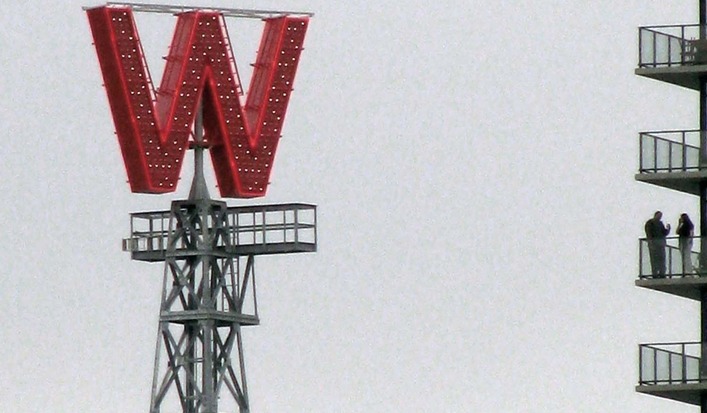
Woodward's Redevelopment
|
|
|
|
Certifications & Awards
Project Team
- Developer: Westbank Projects/Peterson Investment Group
- Architect: Henriquez Partners Architects
- Landscape Architect: Phillips Farevaag Smallenberg
- Concrete Construction: ITC Construction Group
- Funders: Federal, provincial and municipal governments
- Mechanical Engineers: Keen Engineering Company
- Structural Engineers: Glotman Simpson
- Interior Design: Mcfarlane Green Architects
- Electrical Engineers: Arnold Nemetz & Associates
Green Building Audio
 Targeting LEED Green Education Credit?
Targeting LEED Green Education Credit?Our audio tours qualify.
Get one today!
Summary
KEY SUSTAINABILITY FEATURES
- Energy savings target: anticipated energy savings of 33 percent
- Community involvement and affordability: training and hiring program for 28 local residents
- Affordable housing: up to 200 non-market units; low-interest purchasing loans for 15 low-income households
- Local procurement of materials and services
- Re-purposing of underutilized steam plant for hot water generation
The redevelopment of the Woodward’s building is one of the most significant and symbolic components of the revitalization of Vancouver’s Downtown Eastside and its historic neighbourhoods. Encompassing a range of market and non-market housing, stores, civic offices, and a university campus, this neighbourhood-scale redevelopment project is anticipated to attract up to 6,000 residents, shoppers, employees, students and faculty each day.
Constructed in 1903, the original Woodward’s building was Vancouver’s primary retail destination for many decades, providing food and other household necessities to residents well beyond the Hastings Street corridor. Ninety years later, Woodward’s closed its Vancouver location, forcing many of the local businesses along Hastings Street to follow suit. Over the next ten years, the building remained vacant. Finally, in 2003, the City of Vancouver purchased the Woodward’s building from the provincial government and, in 2007, issued a Development Permit for the site.
ENERGY AND ENVIRONMENT
The Woodward’s complex consists of four buildings with 536 market and up to 200 non-market housing units, retail commercial, a public plaza, civic offices, a daycare, and an addition to Simon Fraser University’s downtown campus, the School for Contemporary Arts. The site has excellent access to public transit, and many local area amenities and work places are within short walking distance. Car sharing is provided to reduce dependence on the automobile and minimize space dedicated to parking.
The development is aiming to achieve energy savings of approximately 33 percent. These savings are achieved through the incorporation of a series of high-performance building features, including double-glazed window wall systems, dual flush toilets, and passive solar shading elements such as slab extensions that offer improved weather protection and sun shading. A green screen trellis, along with trees on the rooftop provides natural shading in the summer. Glazed glass canopies ensure continuous weather protection and natural light penetration along the street and below the building edges. A re-purposed old steam plant heats hot water for the entire site. Durable materials are used throughout the project to minimize maintenance requirements and ensure the longevity of building components.
ECONOMY
Woodward’s is expected to act as an economic generator in the neighbourhood, attracting employment for local residents and customers for local businesses. The hope is that the redeveloped Woodward’s may stimulate the local economy in a similar fashion as the original Woodward’s department store. Federal, provincial and municipal governments contributed more than $130 million in tax dollars, tax exemptions and other benefits to the project.
COMMUNITY
The City of Vancouver and the developer engaged the community at every stage of the development process through a number of community outreach initiatives. Eighteen local residents were trained and recruited through programs such as Bladerunners. This local employment program arranged construction jobs for disadvantaged ‘street-involved’ youths during the redevelopment process. The developer also provided fifteen low-interest loans to support buyers who otherwise could not have afforded to purchase units in the development. In addition, plans exist for recruiting local residents for retail and commercial outlets in the development as well as for providing affordable rental space for non-profit community groups. Local procurement of materials and services was a guiding principle at every stage of development.
Sources include:
- Hutchinson, Brian. 2009. “Vancouver downtown east side slowly crawls toward gentrification.” Vancouver Sun, Dec. 18. http://www.nationalpost.com/m/story.html?id=2360078&s=Home
- Manavi, Babak (Graphic Design/ Marketing, Henriquez Partners). Pers. Communication.
- Mata, Robert. 2009. “Woodward’s gets its welcome mat ready.” Globe and Mail, April 3. http://v1.theglobeandmail.com/servlet/story/RTGAM.20090403.wbcdtes03/BNStory/thefix/
- Woodward’s Specifications. http://www.woodwardsdistrict.com/documents/wSpecifications.pdf
- Woodward’s: A New Beginning. N.a, n.d. http://vancouver.ca/bps/realestate/woodwards/
